Alert1 Review
At-home and mobile alert systems backed by quality customer service and fast response

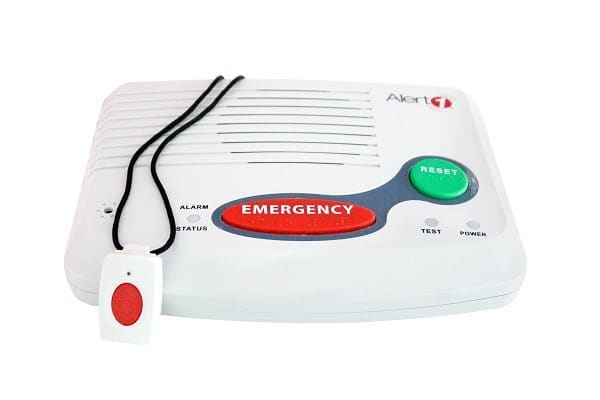
SafeHome.org may receive compensation from some providers listed on this page. Learn More
We may receive compensation from some providers listed on this page. Learn More
At-home and mobile alert systems backed by quality customer service and fast response


What makes one medical alert system different from the next? Having tested several dozen medical alert systems, we can tell you that each system has something unique to offer. For some, price is the differentiator. For others, it’s specific features or design.
Alert1, which has been in the business since 1988,1 sets itself apart by offering a U.S.-based Command Center with 24/7 monitoring and operators that can assist callers in 190 languages. Not only that, but we found that their quick response times (17 seconds!) and clear, two-way talk feature really round out the customer service experience.
Although they have a user-friendly mobile unit, Alert1 systems are probably best for tech-savvy, active seniors. The required landline and short range of the In-the-Home systems will likely rule out a lot of folks who have cut the (phone) cord for cellular service only, as well as seniors who want on-the-go coverage. That said, Alert1’s mobile offerings work great at home as well as out and about. And we think the sleek design of the mobile device will appeal to most seniors.
So let’s get into the nitty-gritty of why an Alert1 medical alert system may — or may not — be the best fit for your needs or the needs of your loved one.
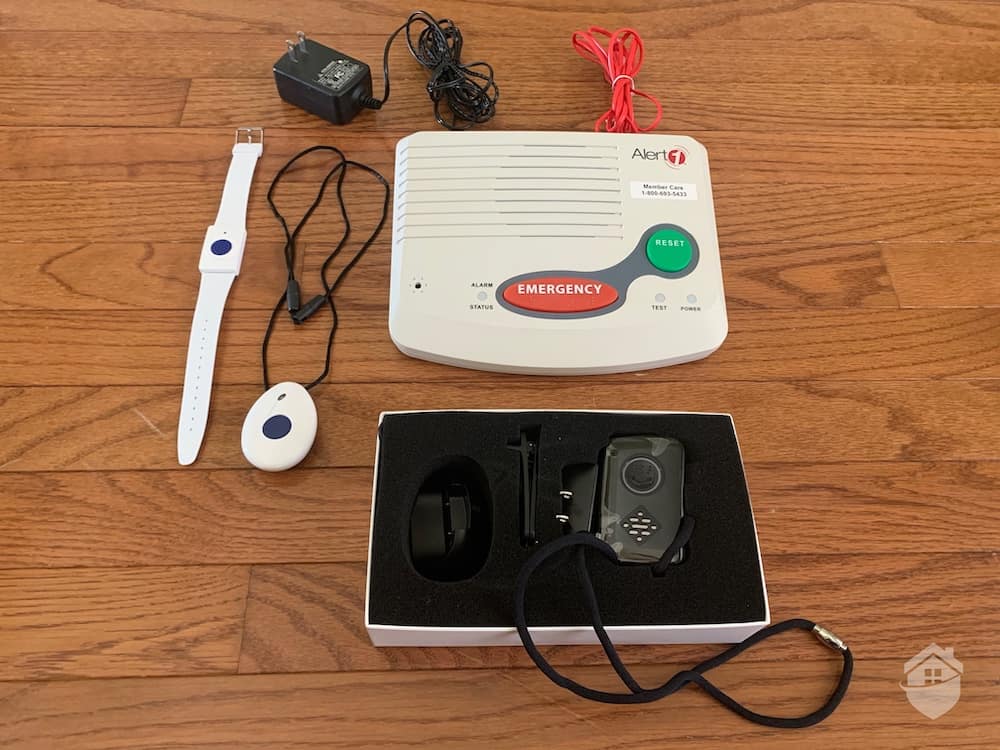
Alert1 Medical Equipment
Check out more recommendations from the SafeHome team:
For every medical alert system we test, we make sure to cover all the bases. We start with the buying process and then unbox and set up the system. In these stages, we focus on the user-experience and the ease of setup and use.
Next, we live with the system, trying out its many features like its wireless range, battery life, and response time. For this part, our focus is the performance.
We followed the same testing protocols with Alert1, and here are our findings.
On the Alert1 home page, we were presented with six different options. That is a lot if it’s your first time shopping for a medical alert system, but don’t worry, we sorted them out.
All six systems basically fall into one or both of these categories: In-Home and On-the-Go. The first two are the basic In-Home system and On-the-Go system. They are the cheapest, starting at $19 and $38 per month, respectively, but they also have the least features.
There is also an In-Home system with fall detection as well as an On-the-Go system with the very same feature. That makes four. These systems with fall detection cost $29 to $48 monthly.
The fifth system is an On-the-Go system, but instead of a classic help button, it comes with a smartwatch. The watch costs $38 monthly, but there’s a one-time equipment fee worth $179.
Lastly, the sixth system is a bundle that includes equipment from both the In-Home and On-the-Go systems with fall detection. This is the most expensive at $58 per month, but it offers the most flexibility as it comes with equipment for home and outside use. We chose this system for tests.
Did You Know? Up-to-date and current user reviews help to build trust for seniors (and their adult children) looking for a reliable device.
As far as pricing goes, note that Alert1 offers monthly and annual payment plans for its monthly subscription. Unlike some medical alert systems, the longer you sign up for, the more money you save.
For the annual plan for the bundle we bought, you’ll pay $49.95 per month, while for monthly payments, it will cost you $58.95 per month. All things considered, this is on the lower end for pricing in the industry. Here’s our latest guide to Alert1 plans and prices.
FYI: Alert1 offers a 30-month payment plan for the best savings, which gives you 6 free months plus free shipping. So if you or your loved one is on a tight budget, and you don’t mind signing a contract, we recommend looking into it.
Just to give you an idea on how Alert1’s pricing compares, let’s put the basic At-Home system without fall detection side-by-side with the MGClassic from Medical Guardian.
Medical Guardian’s pricing is middle-of-the-pack in the industry – not expensive but not too cheap. The MGClassic is their entry-level in-home system that connects to landline just like Alert1’s At-Home system.
| Alert1 At-Home system | Medical Guardian MGClassic | |
|---|---|---|
| Monthly price | $28.95 per month | $29.95 per month |
| Quarterly price | n/a | $29.95 per month |
| Annual price | $19.95 per month | $27.45 per month |
| Connection line | Landline | Landline |
| Add fall detection | $10 per month | $10 per month |
As you can see, the starting price for Alert1 is lower, especially with an annual plan. So if you’re rationing your budget, Alert1 is a good system to consider.
The bundle we bought includes four pieces of equipment. First is the In-Home base unit. This serves as the base for the two other components of the In-Home system, the fall detection pendant and wristband. Now, take note, if you buy a bundle, it includes a fall detection pendant OR wristband, but since we wanted to get a sense of wearing the wristband on a daily basis (some wristbands can be uncomfortable to wear), we opted to pay a little extra to get both units.
The fourth and last piece of equipment is for the On-the-Go system: the mobile fall detection base and pendant. This is one device only, but it comes with a charging cradle.
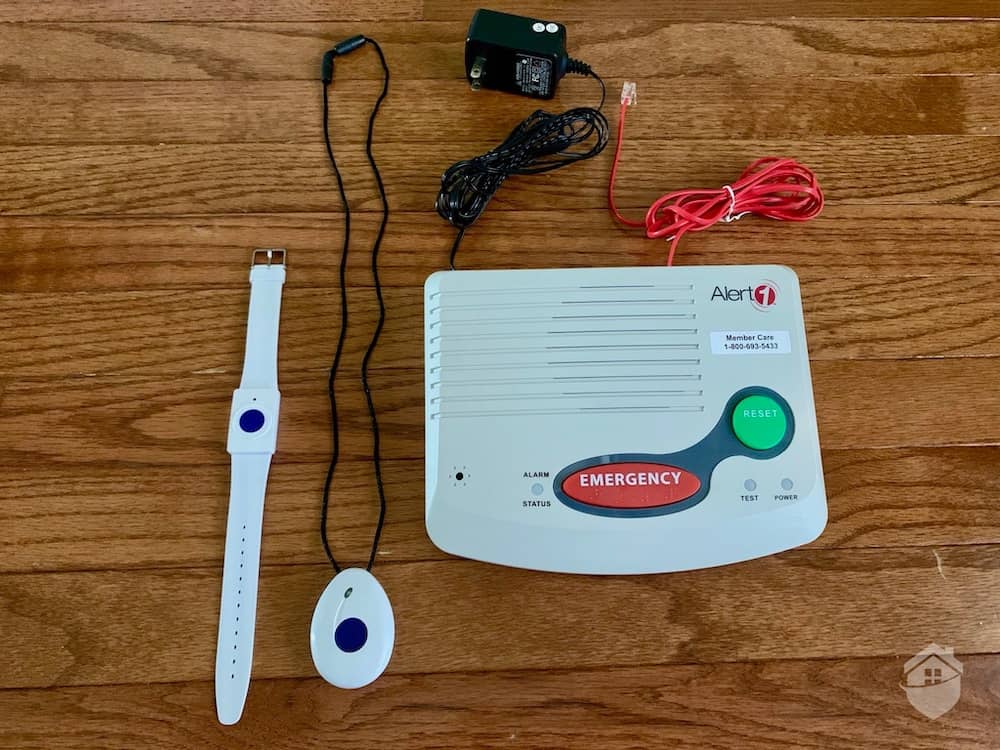
Alert1 At-Home Equipment
Right off the bat, we hit a snag. We plugged in the base unit for the At-Home system — which looks like an old-school beige answering machine — using the included power cord, and attached the included red phone cord into our phone jack. We immediately heard a loud voice (the unit’s microphone is rated at 60 dB)2 telling us, “Telephone line problem. Check the telephone line connection.” That explains why when we pushed the Emergency button to test it, nothing happened.
After a call to Alert1 customer support, we realized the problem: the In-the-Home unit works only with a landline, not VoIP, like we have. Vo-what? That stands for Voice over Internet Protocol, and if you have an internet-TV-phone bundle, you likely have VoIP, too.3 This is an important thing to consider, since more and more people are ditching their landlines in favor of cell phones.
FYI: To use the Alert1 In-Home Medical Alert Landline, you must have a landline that you can connect it to. It will not work with VoIP. Seniors without landlines are better off choosing either the In-Home Cellular unit or the Alert1 Kelsi Mobile Medical Alert.
Not to be deterred, we turned our attention to the mobile device, known officially as the Alert1 Kelsi Mobile Medical Alert. To be honest, it’s far more attractive than the in-home pendant or wristband. It’s sleek, black, and modern-looking, with a circular light that flashes bright blue or red to tell you when it’s charged and ready. In fact, it almost looks like a cell phone or fitness tracker. Although it’s not as elegant as Bay Alarm Medical’s jewelry-styled pendants (we did a full review of Bay Alarm Medical here) we definitely give the Kelsi some style points.
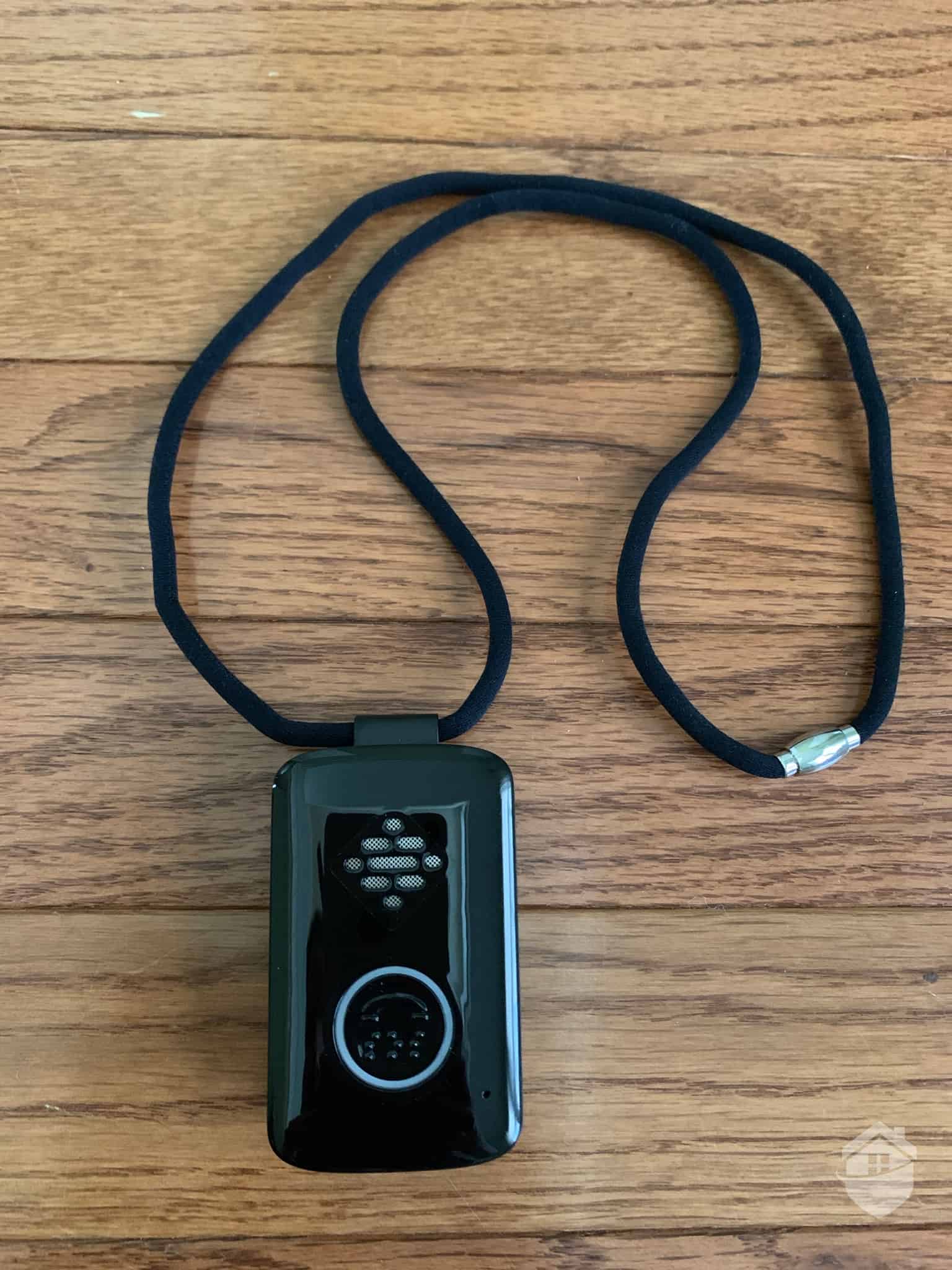
Alert1’s Kelsi
The first step to set it up was to take Kelsi and its charging cradle out of the box. Except for the lanyard and belt clip, that’s all that’s in the box. We then plugged the cradle into a wall outlet, placed Kelsi into it, and that was it. Super simple! Then we just had to let it charge for 2-3 hours to top off the battery. You’ll know it’s fully charged when the battery light around the call button turns solid red.
Pro Tip: According to Alert1, Kelsi’s rechargeable battery can last up to 7 days per charge. But we didn’t get a full 7-days out of ours, and your mileage may vary, too. So it’s wise not to push its limits.
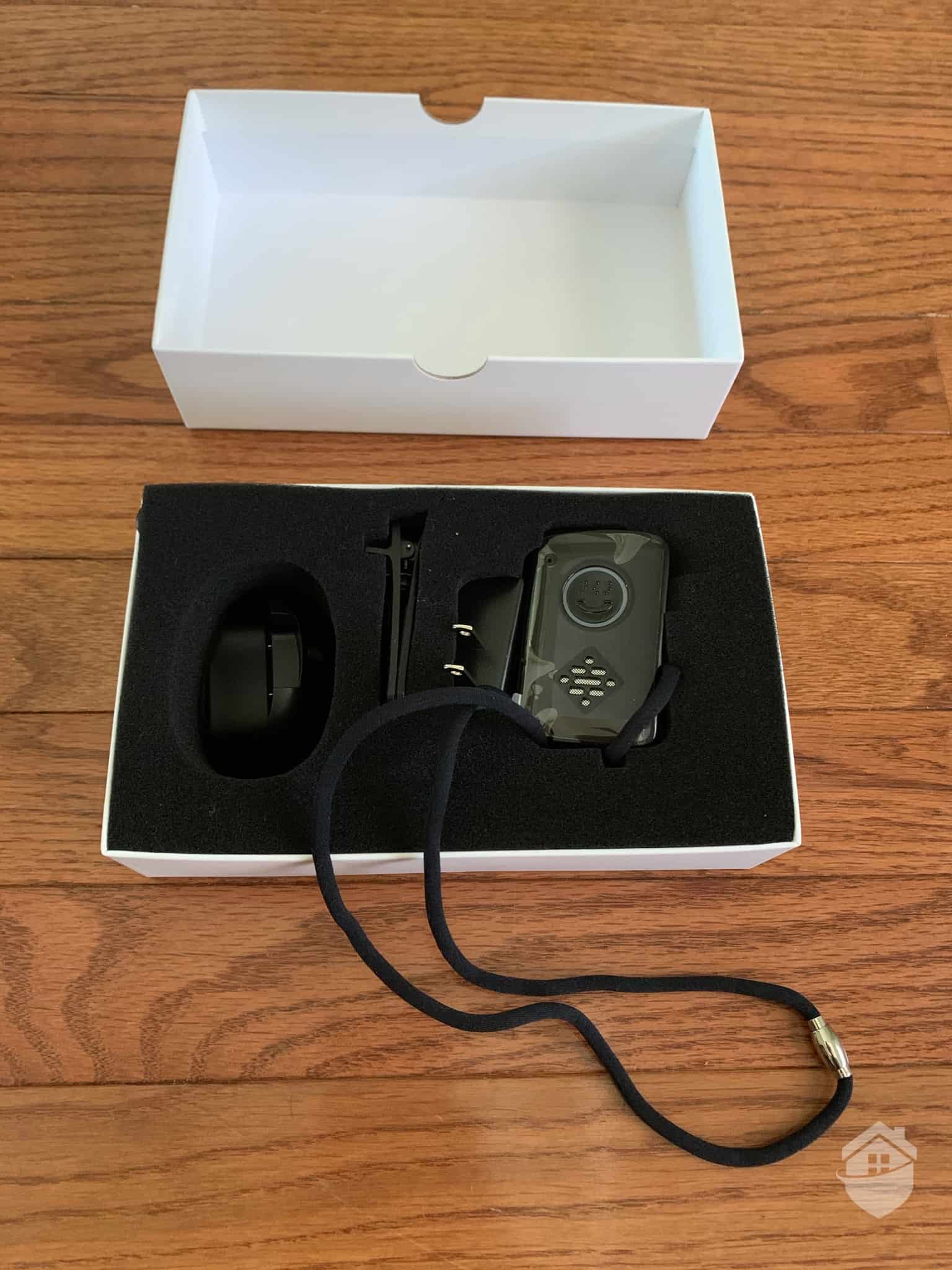
Unboxing the Alert1 Kelsi unit
As the name implies, these are designed to be worn at home, within a 400-foot range of the base station. This is on the short side, as far as range goes. This may work for seniors who live in small apartments, but we’d like to see something in the 600 to 1,200-foot range. Note that the longest range medical alert systems go up to 1,300 feet to give you the most freedom in your home.4
Thankfully, the pendant is lightweight and low-profile. The egg-shaped white pendant with a blue help button in the middle and a tiny indicator light that lights up red when pushed measures 1.5 inches wide by about 2.5 inches high. It won’t win any design awards, but like we said, it’s small and could almost pass for a piece of modern jewelry.
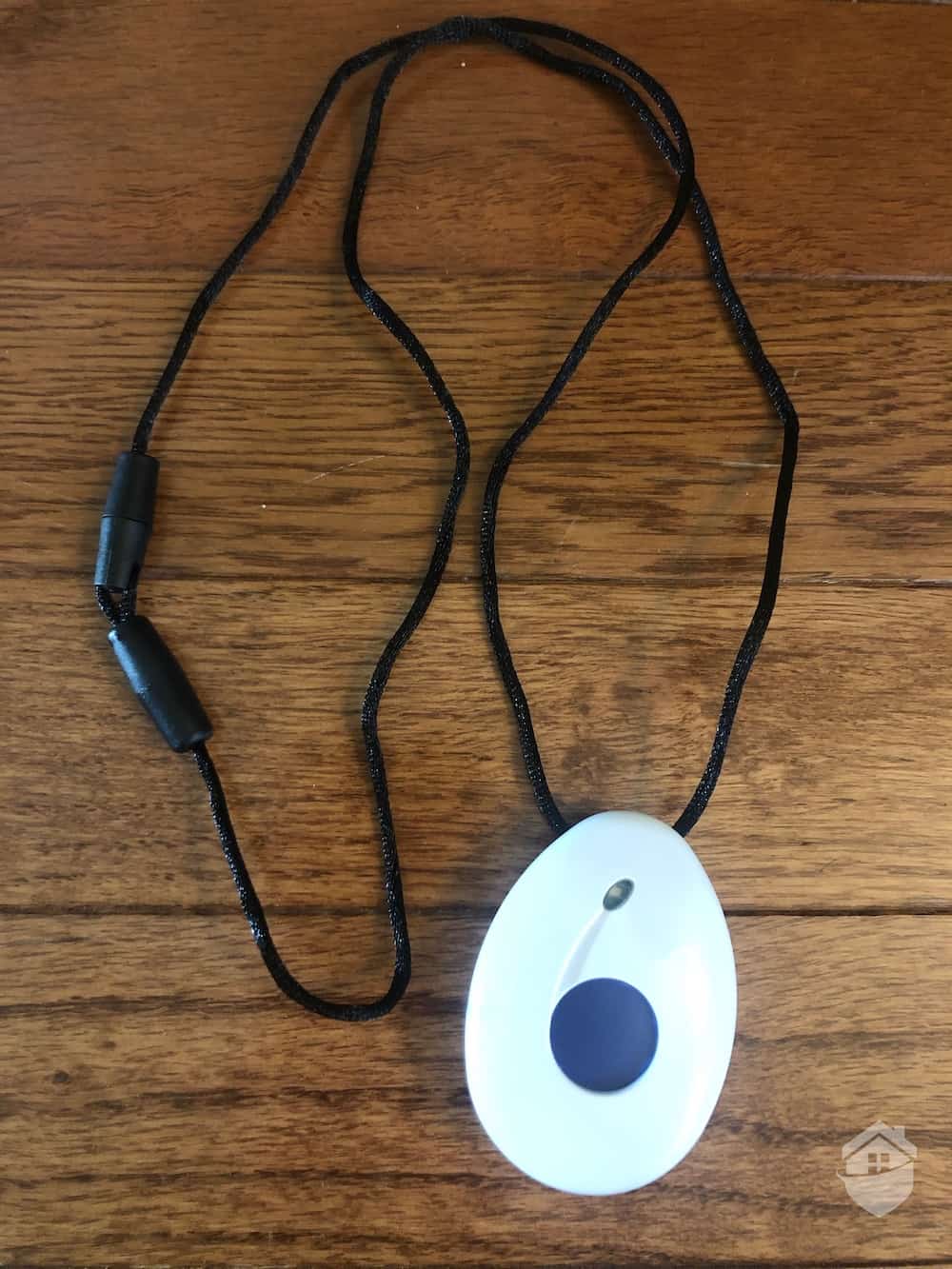
Alert1 Fall Detection Pendant
The wristband also doesn’t win many style points, although it too is simple and sleek with a white plastic band, a round, dark blue help button set in a square “face,” and a tiny indicator light. Our only gripe with it is that it is clearly made for a man’s wrist. On a medium-sized woman’s frame, the strap was loose even on the last hole. That might be a reason for choosing the pendant over the wristband.
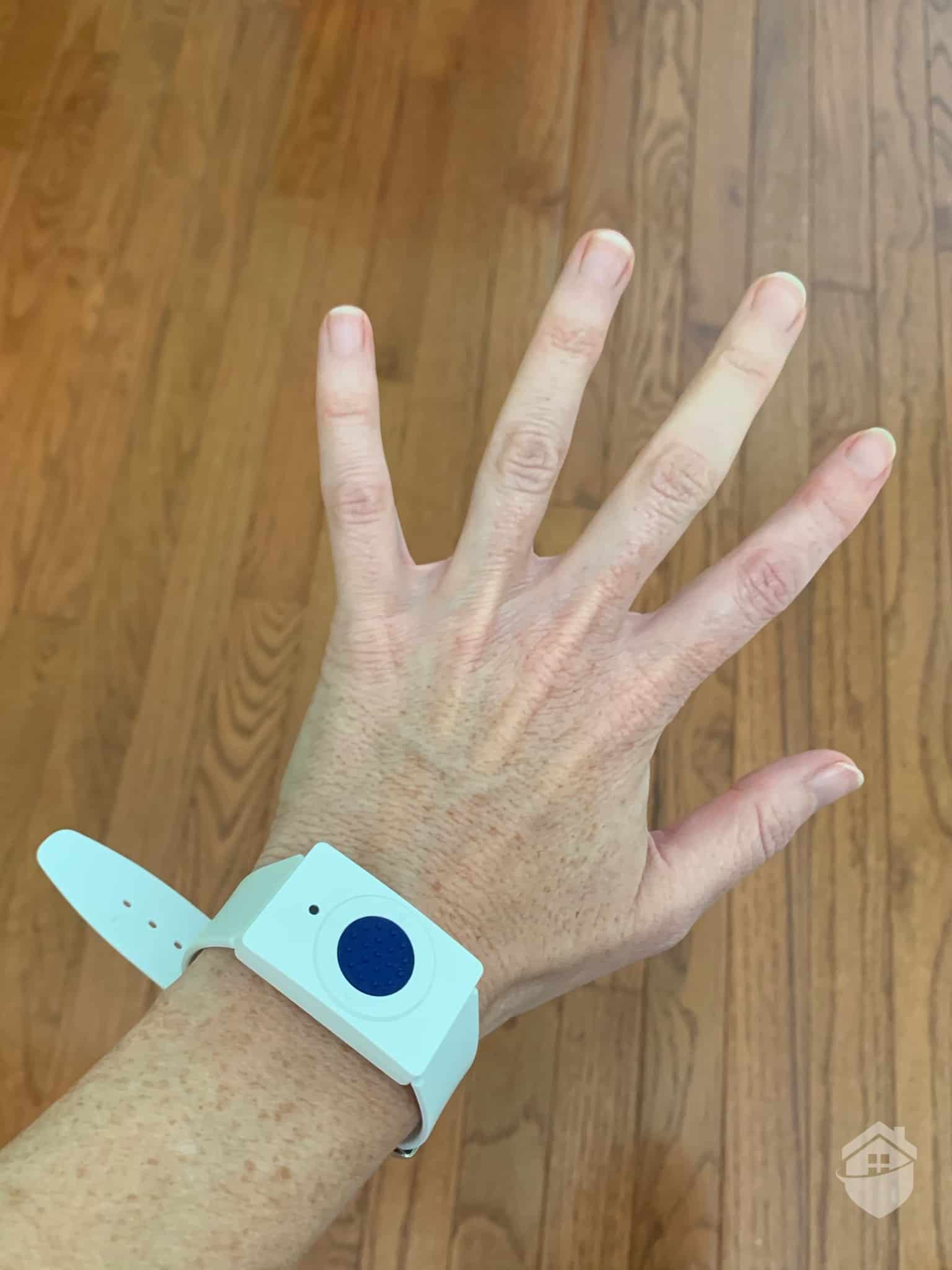
Alert1 Wrist Pendant
FYI: If you’re deciding between a pendant and a wristband, some recent data show that the wrist is the more accurate place for fall detection technology, which is still not 100% accurate.4
This device is designed to wear around your neck if you choose the fall-detection option. As mentioned, it actually looks pretty cool and high-tech. The sleek black device has a speaker and a help button surrounded by a circular light that flashes red and blue. It also has a microphone, a tiny dot we wouldn’t have even known was there if we hadn’t read about it in the User Guide.
That said, the device itself is not small. It measures about 2 inches wide, 3 inches high, and about .75 inches thick. Like all medical alert pendants, it’s supposed to be worn outside your clothes. So you have to be OK with having a black pendant about the size of a Tic-Tac box hanging around your neck. This wasn’t a big deal for us, but we know some folks value a more discreet look.
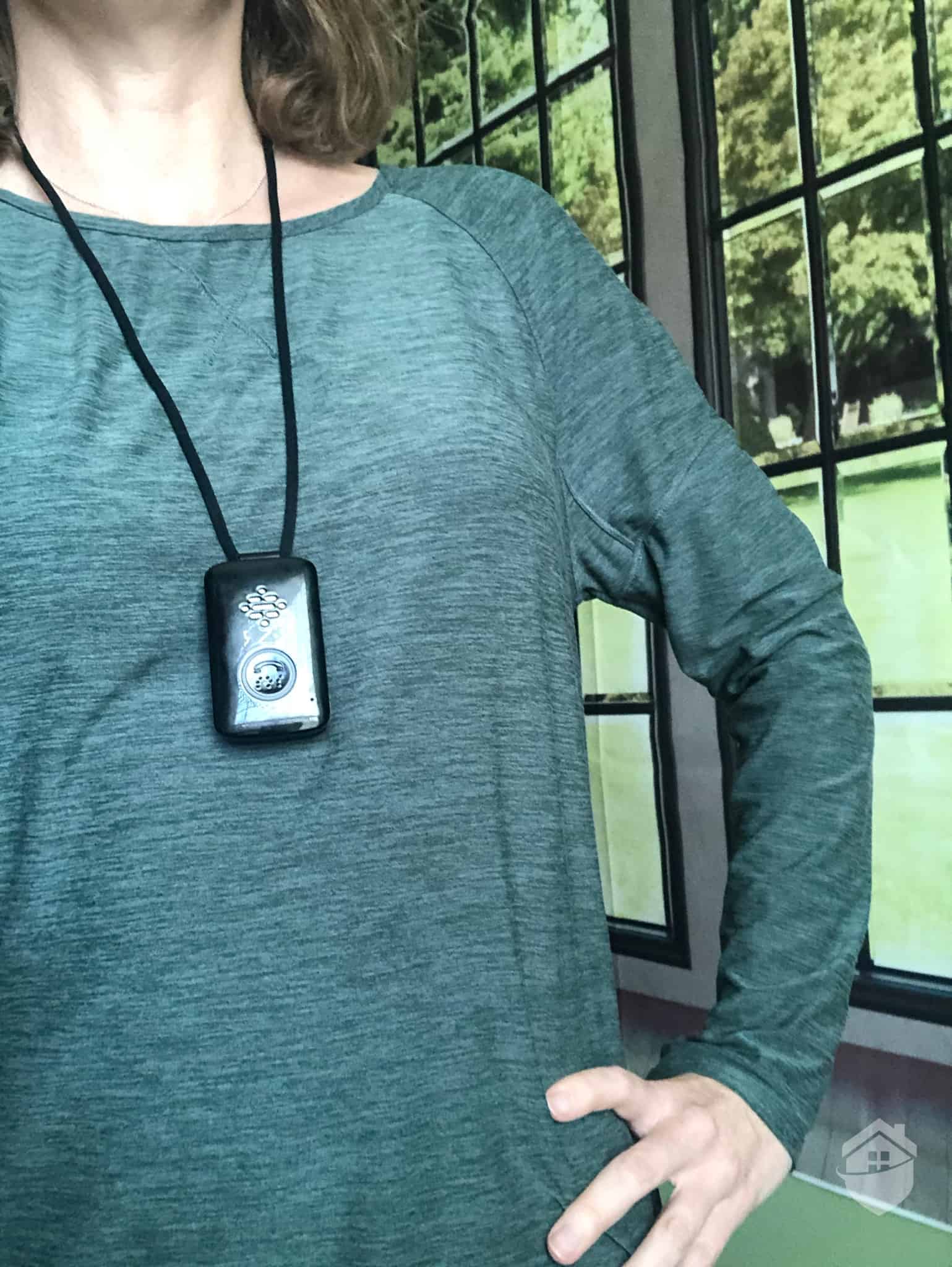
Alert1’s Kelsi mobile unit
Another option, which we preferred, was to attach Kelsi to the included belt clip instead of the lanyard. Somehow, wearing it on our waistband felt less obtrusive. If you ever wore a pager back in the 90’s, you’ll get used to the feeling in no time. And if you’re into this look, we’d recommend checking out Lively’s alert systems. We have plenty of hands-on experience with Lively, a brand that offers award-winning alert systems and mobile phones for seniors.
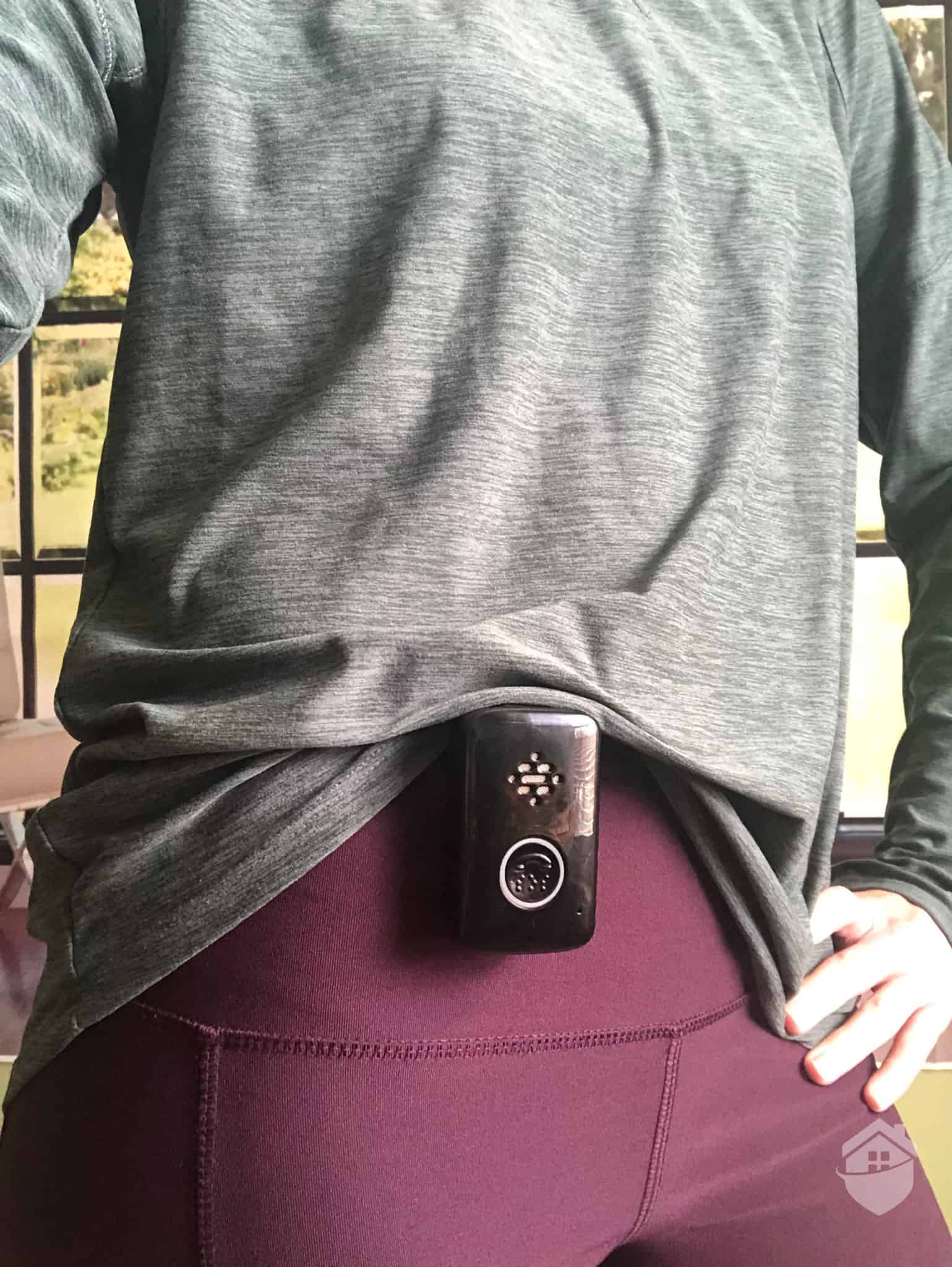
Alert1’s Kelsi mobile unit with Belt Clip
FYI: Alert1’s Kelsi mobile unit is available with or without fall detection, which costs an extra $10 per month.
Most people are more interested in what a medical alert system can do rather than what it looks like, and we’re no exception. We expect reliable service, fast response, and clear communication, and that’s exactly what we got.
When we first tested the Kelsi one evening at home, we were connected to an operator at the Alert1 Command Center within 20 seconds of pushing the help button (17:42 to be exact!). She identified herself by name, spoke clearly, and stayed on the line with us as long as we needed. We have to say, 20 seconds is pretty fast.
Another brand that offers ultra-fast response times is Lifeline. When we tested and reviewed Lifeline, we were downright surprised by their 12 second response times. So if this is important for you or your loved one, you may want to give Lifeline a closer look.
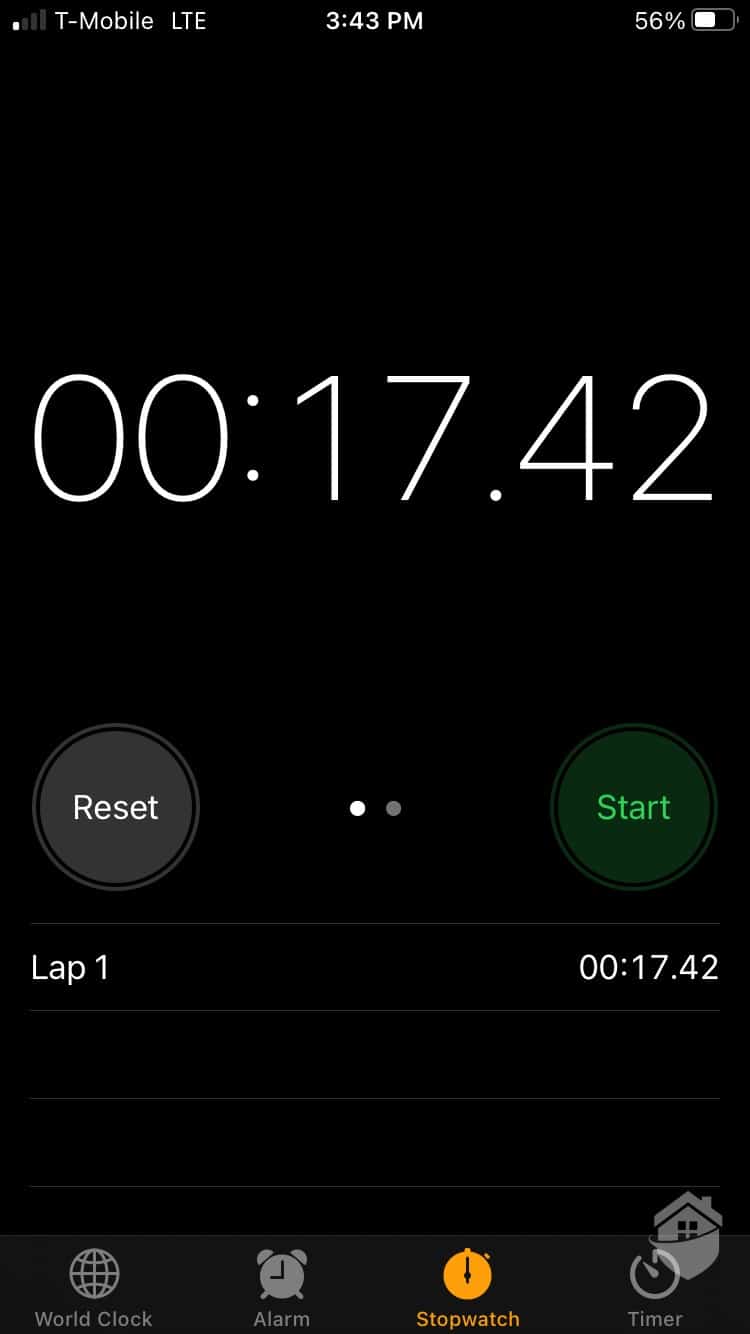
Time to connect to Alert1’s Command Center
According to Alert1’s website, their Command Center is Five-Diamond Certified by The Monitoring Association (TMA) and is regularly inspected by the Underwriters Laboratory.5 Keep in mind that all Command Center operators are based in the U.S. and complete the required TMA training every year.
We were also able to customize exactly whom the operators contacted in the event of an emergency: 911, family, neighbors, or even your doctor. Most brands offer this, but it’s always a nice touch.
Did You Know? Alert1 emergency response operators can offer help in 190 languages. So if English isn’t your mother tongue, you’re still in good hands.
Next, we put Kelsi to a tougher test: we hooked it onto our waistband and headed out for a ride on a nearby bike trail notorious for spotty cell service. And yet, when we pushed the help button, an operator responded in less than 18 seconds! Also, it’s worth mentioning that the two-way talk feature was louder and more clear than our smartphone in certain places.
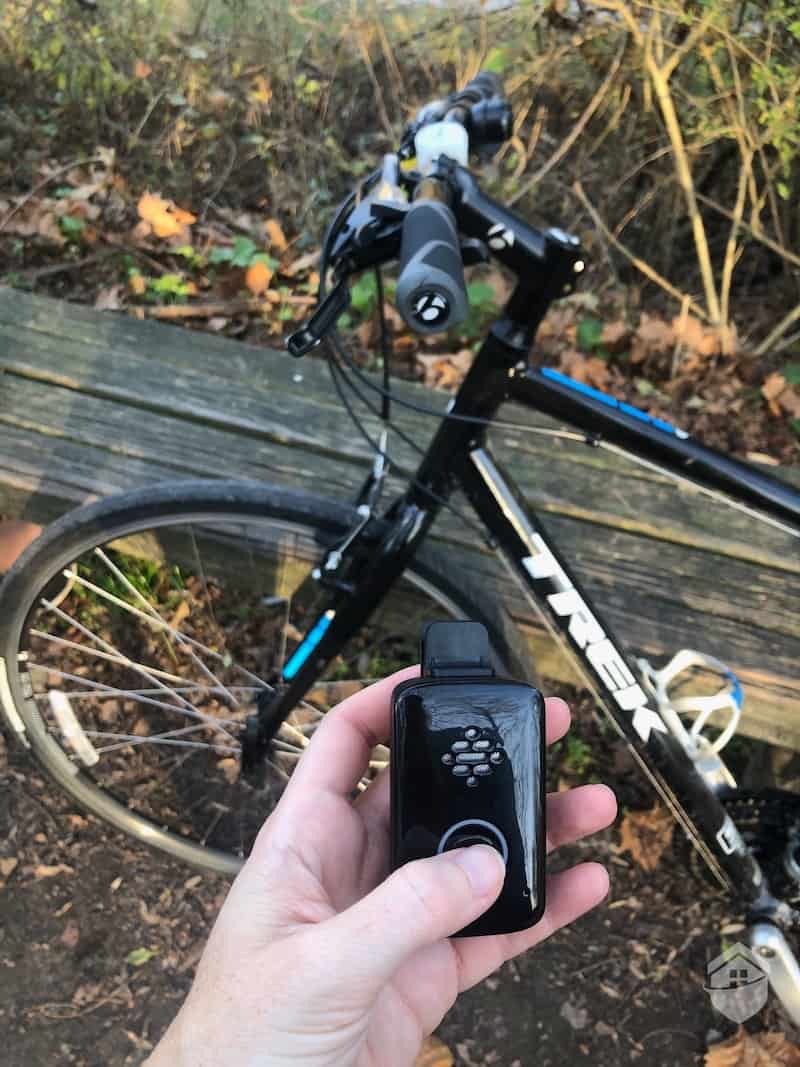
Pushing Alert1’s Kelsi mobile unit button
Now let’s talk about fall detection. The At-Home pendant also comes with this feature, but since Alert1’s Kelsi is a mobile device, it adds a couple useful features to fall detection.
First is cellular connectivity, the same connectivity this mobile device uses for its speedy response times. After talking to an Alert1 rep, we learned that they use the Verizon network, which he claimed to offer coast-to-coast coverage for the Kelsi device.
The second feature is GPS tracking. Since this is designed to be taken with you wherever you go, the GPS feature will help emergency responders pinpoint your location in case you’re unable to relay that information to them. This helps ensure you get the help you need in time.
By any means, these features aren’t unique to Alert1’s mobile fall detection, but we do think it’s a positive that they are included.
As we said above, setting up the Alert1 systems doesn’t get much easier than this. Especially for the Kelsi mobile device, as soon as it was charged up, we just popped it on the lanyard or belt clip and were good to go. So we think it’s a great fit even for the tech-averse seniors out there.
The one thing we wished was a little clearer was the lights. To us, it was a little counterintuitive that red means the battery is fully charged. Also, while Kelsi is in the charging cradle, the circular light around the call button flashes red AND blue. The User Guide doesn’t fully clarify what this means.
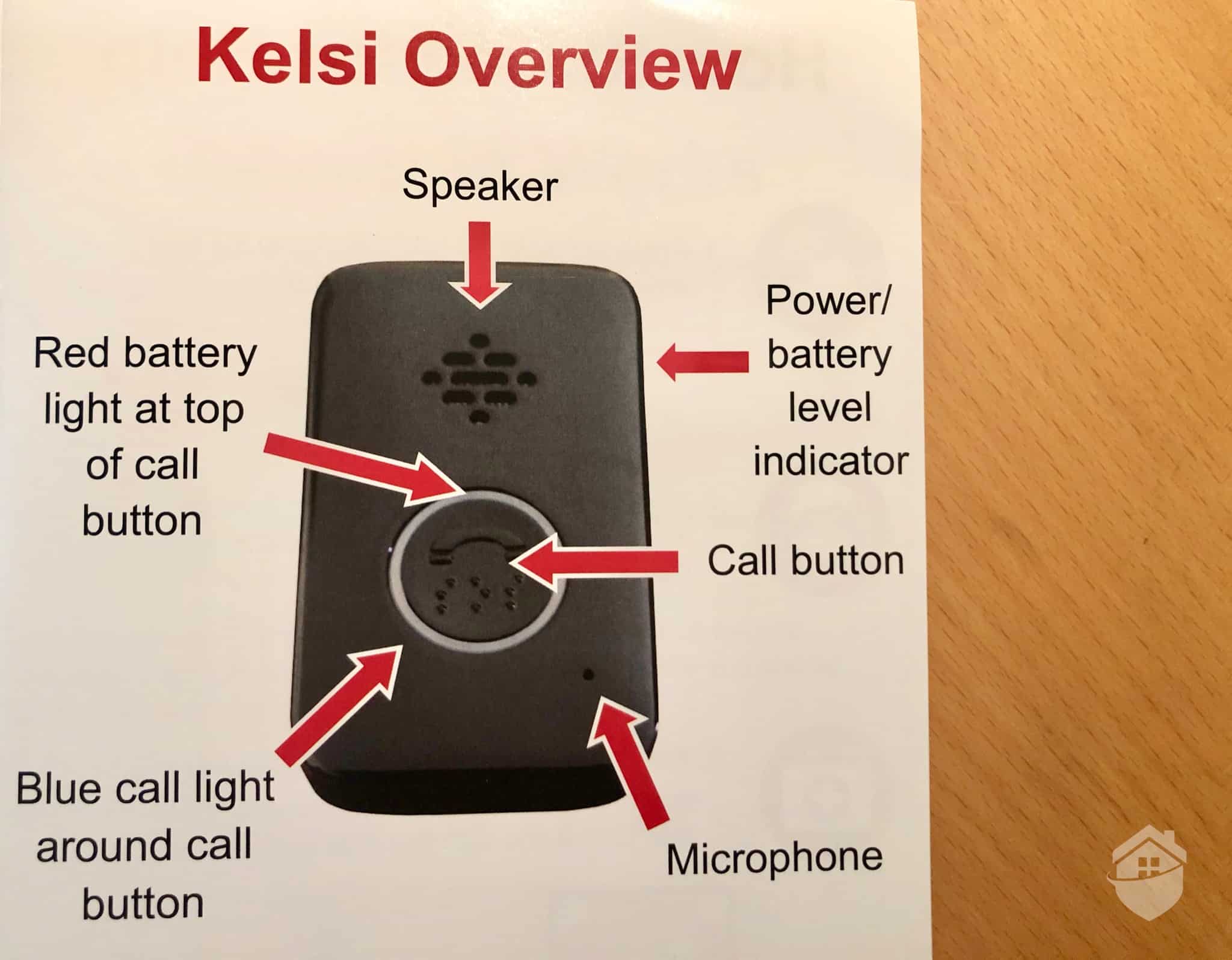
Alert1’s Kelsi Packaging
The Troubleshooting page explains that while off the charger, the light will flash blue every 2 seconds while in active mode, but if it flashes blue every 1 second, it’s out of service. This seemed a little confusing to us.
There is a small power/battery level indicator on the side of the device. When you press it, it tells you, for example, “Battery low. Please charge.” While the User Guide says Kelsi’s battery can last up to 7 days per charge, in our experience it lasted only a few days. These are minor complaints, but still, they’re something to look out for.
Alert1 is a trusted company that’s been in the medical alert business since 1988 and serves all 50 states. So they must be doing something right. While the clarity of their written materials — their website and User Guides — could be improved, their response time and customer service were top-notch.
We were particularly impressed by the design and quality of their Kelsi mobile device. There’s a little bit of a learning curve figuring out what the different lights mean, but once you’re up to speed, the Alert1 mobile system is very easy to use. And with sub-20 second response times, we’d feel confident letting Alert1 monitor our aging mother.
At $31-$53 per month for In-the-Home and On-the-Go systems that include fall detection, Alert1 is a bit pricier compared to more affordable alerts like Medical Guardian. Remember, though, if you don’t have a landline or you live in a larger home, you probably don’t want the In-the-Home option. We recommend you go with the Kelsi mobile device with fall detection. This option is best for active seniors, and we think the look of the Kelsi makes it a better choice, too.
Alert-1: About Us. (2020). Alert1 Medical Alert Systems.
https://www.alert-1.com/company/why-choose-us/329
Earq. (2020). What Are Decibels (dB)?
https://www.earq.com/hearing-health/decibels
Nextiva. Masjedi, Y. (2020). What Is VoIP & How Does It Work?
https://www.nextiva.com/blog/what-is-voip.html
MobiHealthNews. Comstock, J. (2019, April 19). How fall detection is moving beyond the pendant.
https://www.mobihealthnews.com/content/how-fall-detection-moving-beyond-pendant
TMA. (2020). Monitoring Certification Program.
https://tma.us